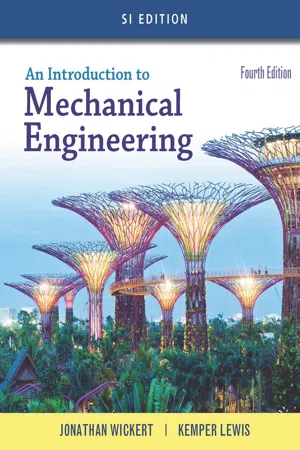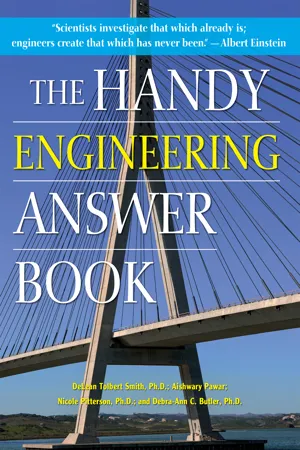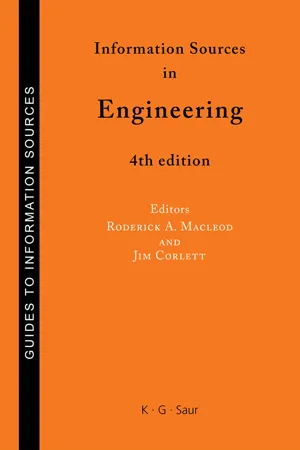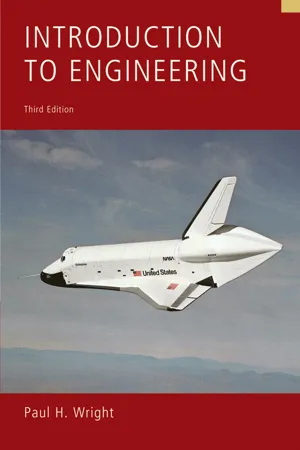Technology & Engineering
Mechanical Engineering
Mechanical engineering involves the design, analysis, and manufacturing of mechanical systems and components. It encompasses a wide range of industries, including automotive, aerospace, and energy. Mechanical engineers apply principles of physics and materials science to develop innovative solutions for various mechanical challenges.
Written by Perlego with AI-assistance
Related key terms
1 of 5
7 Key excerpts on "Mechanical Engineering"
- Jonathan Wickert, Jonathan Wickert, Kemper Lewis(Authors)
- 2016(Publication Date)
- Cengage Learning EMEA(Publisher)
Robotic welding systems (Figure 1.1), internal combustion engines, sports equipment, computer hard disk drives, prosthetic limbs, automobiles, aircraft, jet engines, surgical tools, and wind turbines are some of the thousands of technologies that Mechanical Engineering encompasses. It would not be much of an exaggeration to claim that, for every product you can imagine, a mechanical engineer was involved at some point in its design, materials selection, temperature control, quality assurance, or production. Even if a mechanical engineer didn’t conceive or design the product per se, it’s still a safe bet that a mechanical engineer designed the machines that built, tested, or delivered the product. Mechanical Engineering has been defined as the profession in which power-producing and power-consuming machines are researched, designed, Figure 1.1 Robots are used in environments that require precise and repetitive tasks such as industrial assembly lines and in extreme environments like this deep sea repair on a corroded pipe. Paul Fleet/Shutterstock.com Copyright 201 Cengage Learning. All Rights Reserved. May not be copied, scanned, or duplicated, in whole or in part. Due to electronic rights, some third party content may be suppressed from the eBook and/or eChapter(s). Editorial review has deemed that any suppressed content does not materially affect the overall learning experience. Cengage Learning reserves the right to remove additional content at any time if subsequent rights restrictions require it. 1.1 Overview 3 and manufactured. In fact, mechanical engineers devise machines that produce or consume power over the remarkably wide scale shown in Figure 1.2, ranging from nanowatts (nW) to gigawatts (GW). Few professions require a person to deal with physical quantities across so many orders of magnitude (one quintillionfold or a factor of 1,000,000,000,000,000,000), but Mechanical Engineering does.- Jonathan Wickert, Kemper Lewis, Jonathan Wickert(Authors)
- 2020(Publication Date)
- Cengage Learning EMEA(Publisher)
Robotic welding systems (Figure 1.1), internal combustion engines, sports equipment, computer hard disk drives, prosthetic limbs, automobiles, aircraft, jet engines, surgical tools, and wind turbines are some of the thousands of technologies that Mechanical Engineering encompasses. It would not be much of an exaggeration to claim that, for every product you can imagine, a mechanical engineer was involved at some point in its design, materials selection, temperature control, quality assurance, or production. Even if a mechanical engineer didn’t conceive or design the product per se, it’s still a safe bet that a mechanical engineer designed the machines that built, tested, or delivered the product. Mechanical Engineering has been defined as the profession in which power-producing and power-consuming machines are researched, designed, Figure 1.1 Robots are used in environments that require precise and repetitive tasks such as industrial assembly lines and in extreme environments like this deep sea repair on a corroded pipe. Paul Fleet/Shutterstock.com Copyright 2021 Cengage Learning. All Rights Reserved. May not be copied, scanned, or duplicated, in whole or in part. Due to electronic rights, some third party content may be suppressed from the eBook and/or eChapter(s). Editorial review has deemed that any suppressed content does not materially affect the overall learning experience. Cengage Learning reserves the right to remove additional content at any time if subsequent rights restrictions require it. 1.1 Overview 3 and manufactured. In fact, mechanical engineers devise machines that produce or consume power over the remarkably wide scale shown in Figure 1.2, ranging from nanowatts (nW) to gigawatts (GW). Few professions require a person to deal with physical quantities across so many orders of magnitude (one quintillionfold or a factor of 1,000,000,000,000,000,000), but Mechanical Engineering does.- eBook - ePub
- DeLean Tolbert Smith, Aishwary Pawar, Nicole P. Pitterson, Debra-Ann C. Butler(Authors)
- 2022(Publication Date)
- Visible Ink Press(Publisher)
Mechanical Engineering What is Mechanical Engineering? Mechanical Engineering is one of the broadest engineering professions. It focuses on making innovations to address human issues with an adequate understanding of core areas—for example, knowledge and application of mechanics, thermodynamics, materials science, etc., to deal with the design, development, and utilization of machines. For this design and analysis, mechanical engineers use computer-aided design (CAD), computer-aided manufacturing (CAM), and product life cycle management. Thus, it includes the design, production, and operation of machinery. HISTORY What is the history of Mechanical Engineering? With the development of civilization, the emergence of Mechanical Engineering started from the first steam engine, which is dated from ancient Greece, the work of Hero (or Heron) of Alexandria. Then, at that point, during the Islamic Golden Age (from the seventh to the fifteenth century), Ismail al-Jazari’s book The Book of Knowledge of Ingenious Mechanical Devices was written in 1206. The first professional society for mechanical engineers, the Institute of Mechanical Engineers, was formed in the United Kingdom in 1847. The first power-driven machines were made during the nineteenth century; then, during the twentieth century, more advanced systems were built. The development of physics and machine tools during the nineteenth century permitted the separation of Mechanical Engineering from the rest of the engineering subdisciplines. This led to the manufacturing of machines and engines to power them. Indeed, one of the primary difficulties of Mechanical Engineering was the creation of power-driven systems - eBook - PDF
- Roderick A. Macleod, Jim Corlett, Roderick A. Macleod, Jim Corlett(Authors)
- 2012(Publication Date)
- De Gruyter Saur(Publisher)
23 Mechanical Engineering Michael Richards The purpose of offering information sources is twofold: to provide students, practitioners, librarians and information scientists with the necessary contacts to obtain the information they require; and to equip them with enough details to establish a physical working library of any size or depth. While this is an enormous task with even small subject areas, Mechanical Engineering offers its own particular set of questions and ambiguities -mainly in the area of definitions. Mechanical Engineering, succinctly defined by James (1998), is the 'process, skills and technology used to achieve optimised >metamorphosis= of materials into components, machines and structures'. Thus, in engi-neering terms, anything - and everything - manmade, whatever its degree of sophistication, can healthily be argued to come under the heading of Mechanical Engineering. Even if the notion of machinery, defined by The Oxford Shorter Dictionary as 'an apparatus for applying mechanical power, consisting of a number of parts, each having a definite function', is introduced to reduce this universal manufactory warehouse, none of its components is actually obsoleted. Gloriously, the history of Mechanical Engineering traces the history and evolution of the human race. Clearly, for our present purpose, such a broad perspective will not do, even before considering concepts such as fuel, energy, control, power and heat, so definitions provided by EEVL; the Internet guide to engi-neering, mathematics and computing (www.eevl.ac.uk/engineering/ engsubjectguide.htm) are largely followed. • Mechanical Engineering: mechanics, design, drives and transmission, lubricants and lubrication, measuring instruments. • A u t o m o t i v e engineering: automotive engines, buses, tractors, trucks. • C o n t r o l engineering: automatic control principles, applications, devices. - eBook - PDF
- Paul H. Wright(Author)
- 2012(Publication Date)
- Wiley(Publisher)
For example, they design turbines; printing presses; earth-moving machinery; food processors; air conditioning and refrigeration systems; artificial hearts and limbs; and engines for aircraft, diesel locomo- tives, automobiles and trucks, and public transportation vehicles. Their machines move and lift loads, transport people and goods, and produce energy and convert it to other forms. In the power specialty, mechanical engineers are involved in the design, production, and operation of hydraulic turbines for driving electric generators and of boilers, engines, turbines, and pumps for the development of steam power. They design and operate power plants and concern themselves with the economical combustion of fuels, the conversion of heat energy into mechani- cal power, and the use of that power to perform useful work. In heating, ventilation, and air conditioning, mechanical engineers pro- vide controlled conditions of temperature and humidity in homes, offices, 2.5 Mechanical Engineering 27 BIOENGINEERING Bioengineering is an interdisciplinary field that applies engineering prin- ciples to the study of biological processes. The purpose of bioengineering research is to develop new and better physical and mathematical con- cepts and techniques that address problems in medicine and biology. Bioengineering is being applied to a wide variety of problems, including the design and development of new medical devices such as assistive devices for people with spinal cord injuries and sensory aids for people with poor vision. Recent bioengineering research has included the devel- opment of ultrasonic and magnetic resonance instrumentation, which produce better imaging for medical diagnoses and treatment (9). commercial buildings, and industrial plants. They develop equipment and sys- tems needed for the refrigeration of foods and the operation of cold storage warehouses and ice manufacturing plants. - eBook - PDF
- Nelson Bolívar(Author)
- 2019(Publication Date)
- Arcler Press(Publisher)
Mechanical design – bolts, nuts, welds, gears; v. Experimental instrumentation and engineering; vi. Computational techniques – transforming continuous mathematical equations into discrete mathematical equations; vii. Dynamics – principally F = ma applied to several different types of systems; viii. Core “engineering science;” ix. Thermodynamics; Fundamentals of Mechanical Design and Engineering 11 x. Heat transfer; xi. Properties and Strength of materials; xii. Control systems; xiii. Senior “capstone” design project; xiv. Fluid mechanics. Figure 1.1: SAE Formula Racecar Project at the University of Southern Cali-fornia, that is; examples of industries using MEs. Source: http://www.uscformulasae.com Numerous industries hire mechanical engineers; below mentioned are several industries and types of systems which require services of mechanical engineers: i. Engines, transmissions in Automotive; ii. Control systems; iii. Suspensions in Aerospace; iv. Combustion in Automotive; v. Stress analysis; vi. Fluid mechanics (external & internal) in Biomedical (with physicians); vii. Heat transfer in turbines; viii. Transport and flow in vivo in Computers (with computer engineers); ix. Biomechanics – prosthesis; Creative Design of Mechanical Devices 12 x. The packaging of systems and components in Construction (with civil engineers); xi. Heat transfer; xii. Ventilation, heating, air conditioning (HVAC); xiii. Steam power cycles – heat and work; xiv. Oil drilling – fluid flow, stress, and structures; xv. Mechanical design of generators, turbines, etc. in petrochemicals (with petroleum, and chemical engineers); xvi. Stress analysis in Electrical power generation systems (with electri cal engineers); xvii. Mechanical design of sensors, and actuators; xviii. Design of refineries – pressure vessels, piping in Robotics (with electrical engineers) (Staley and Guthrie, 1998; Seeger and Crary, 1997; Ulrich and Seering, 1990; Jensen et al., 1999). - eBook - ePub
- Carolina Machado, J. Paulo Davim, Carolina Machado, J. Paulo Davim(Authors)
- 2017(Publication Date)
- De Gruyter(Publisher)
This chapter was prepared and written in presentation format, so it is easy to read and follow. I hope all readers will find it useful.7.1The objective of Mechanical Engineering
Engineering is an occupation whose goal is to develop methods for the economic use of resources, potentials, and materials in nature, for the benefit and welfare of human beings. This is accomplished by a reasoning process of experience and practical knowledge gained from the fundamental sciences and mathematics.The main objective of engineering is to develop existing technology and bring into existence new systems for human use by introducing the design and production of innovative technical applications in consideration of scientific knowledge.The most important infrastructure in terms of producing unique technology is fundamental scientific research and qualified manpower and brain power.The capabilities and contributions of engineers are so important that those capacities affect directly the assessment by educated people of the potential of a society or country and even the entire world.During the engineering execution period, engineers generally think, search, plan, design, and conceive projects and implement, produce, and manage the related industrial and business activities. The research capabilities of engineers are as important as their scientific knowledge and field experience.In addition to producing unique technology, engineers should carry out tasks related to technology transfer, adaptation, matching, customization, implementation, and usage.The place of Mechanical Engineering in society and its importance can only be described by introducing and presenting in detail the jobs involved in the field. A strong relationship exists between a country’s reconstruction and industrialization, and this relationship cannot be ignored. Industrial progress is one of the cornerstones of community development. Mechanical Engineering is one of the most important driving forces for in periods of industrialization and development for a country and for the world.
Index pages curate the most relevant extracts from our library of academic textbooks. They’ve been created using an in-house natural language model (NLM), each adding context and meaning to key research topics.






